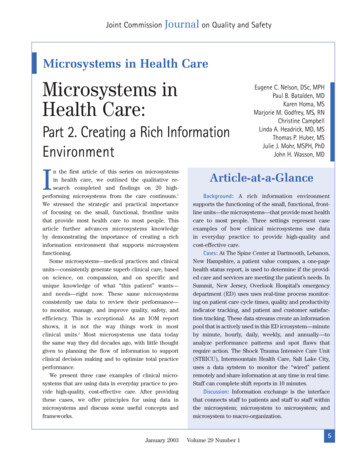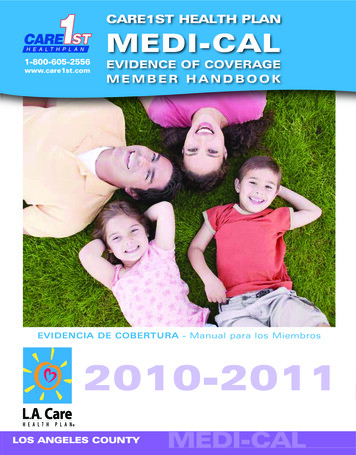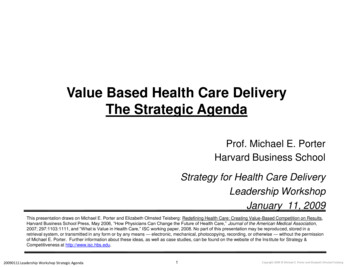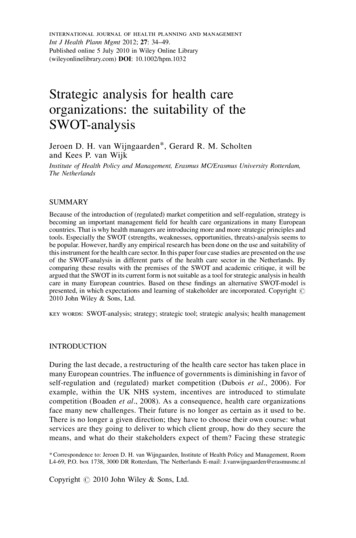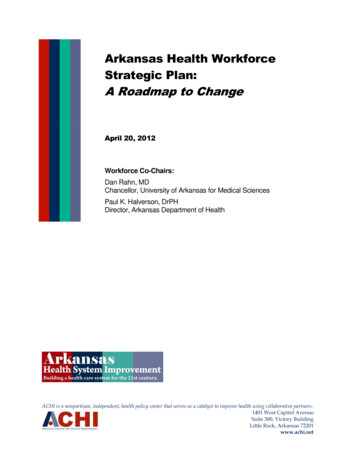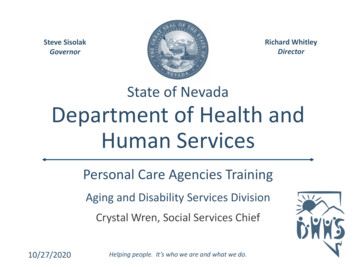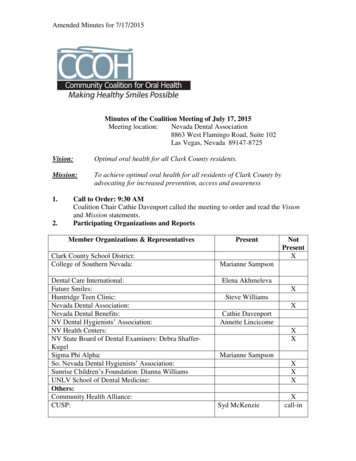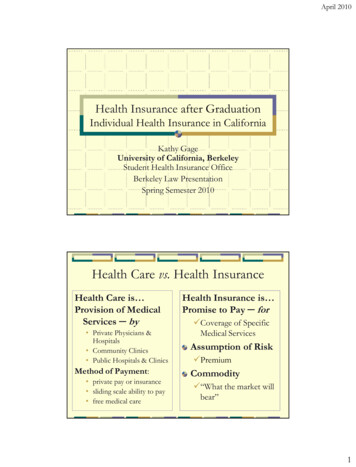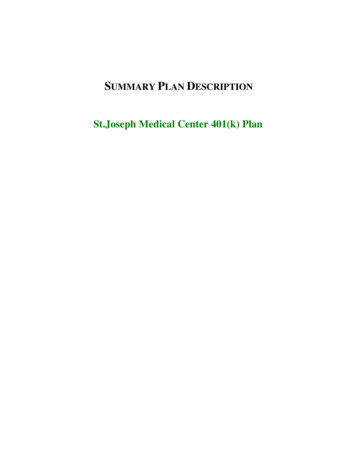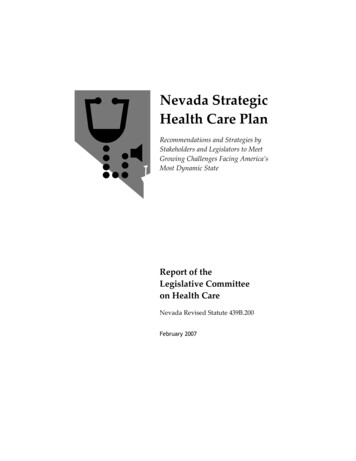
Transcription
Nevada StrategicHealth Care PlanRecommendations and Strategies byStakeholders and Legislators to MeetGrowing Challenges Facing America’sMost Dynamic StateReport of theLegislative Committeeon Health CareNevada Revised Statute 439B.200February 2007
Nevada Strategic Health Care PlanTable of ContentsExecutive Summary .1Process and Results.12Focus Group Participants .17Recommendations and StrategiesHealth Care Professional Education .22Medicaid and SCHIP .30Small Employers .40Safety Net Coverage .46Behavioral Health .50Prevention and Wellness .59Health Care Planning .65Health Care Status Indicators.73Sources.76
EXECUTIVE SUMMARYA State Health Plan for NevadaAn effective health agenda to meet the growing challenges facing America’s most dynamic stateIN RECOGNITION OF the existing and anticipated challengesassociated with meeting Nevada’s health care needs,Assembly Bill 342 (Chapter 418, Statutes of Nevada 2005)directed the Legislative Committee on Health Care (LCHC)to undertake a wide-ranging effort to develop a NevadaState Health Plan, to include, without limitation, a review ofNevada’s health care needs as identified by State agencies,local governments, providers of health care, and the generalpublic.Environment at a GlanceEven a cursory review of health care indicators revealsthat Nevada has serious issues facing its health care system.The health care system in Nevada faces the following challenges:Shortage of Health Professionals. Nevada suffers from a severe shortage of health care professionals. Nevada ranks48th among the states in the number of physicians per100,000 population,1 49th in the number of nurses per100,000 population, 2 48th in the number of dentists,3 and48th in the number of social workers.4 In its current condition, Nevada’s education system cannot keep up with theneed.Uninsured Residents. A large percentage of Nevada’spopulation is without health insurance. In a ranking ofstates by the uninsured rate, Nevada is tied for fourth highest with approximately 19%, or 426,000, of its citizens uninsured.5Rapid Population Growth. Nevada’s population growthrate is the nation’s highest. By 2030 the state’s populationwill more than double, to 4.3 million. Additionally, by 2030the 65-plus age group (the group with the highest healthcare utilization and cost) will make up a larger share (19%,compared to 11% in 2000) of this much larger population.6Low Medicaid Coverage. Compared to the rest of the nation, Nevada has a very low percentage of its populationcovered by Medicaid. Depending on the measure, NevadaMedicaid covers between 7% and 11% of the state’s totalpopulation, which is just over half the average percentagecovered by the rest of the states. In terms of Medicaid coverage of the state’s population, Nevada ranks 47th among thestates.7 This situation contributes to the high level of theuninsured, lessens the volume of federal dollars returning toNevada, shifts uninsured persons’ health care risks andNevada Strategic Health Care Plan - 2007costs to the insured population, and results in the uninsureddelaying medical treatment until a costly emergency roomvisit is the only care option.Low Health Status. Nevada’s overall health status ranked37th in a survey performed by the United Health Foundation. Poor indicators are noted in child immunizations,prenatal care, and the size of the state’s uninsured population.8Behavioral Health Issues. Nevada ranks second among thestates in the percentage of the population with poor mentalhealth, first among the western states in the prevalence ofthe population with mental illness, and 37th in overall mental health care spending.9Plan DevelopmentIn developing the Plan, the Legislative Committee onHealth Care (LCHC) relied heavily on input from stakeholders involved in the State’s health care system. Thisinvolvement included the receipt of testimony during theten interim meetings of the Committee, the participation ofapproximately 100 individuals in six separate focus groups,and, finally, the convening of a Stakeholders’ Health Summit that attracted 76 participants. The consensus recommendations adopted during the Summit form the basis ofthe Nevada State Health Plan.Recommendations and StrategiesSeven major recommendation statements and 39 consensus strategies emerged from the process to form the NevadaState Health Plan. The seven major recommendation statements include: Health Care Professional Education. Improve andexpand the State’s capacity to provide a health careprofessional education continuum to increase thenumber of licensed health care professionals in thestate. Medicaid and SCHIP. Expand program eligibility,enrollment and service coverage under the State’sMedicaid and SCHIP programs. Small Employer Health Insurance. Develop mechanisms to provide coverage for the small employer market.1
Executive Summary The Safety Net. Improve access to services for both theinsured and uninsured by supporting and expandingthe safety net provider network. Behavioral Health. Increase access to and funding foran appropriately designed mental health and substance abuse program for Nevadans requiring theseservices. Prevention and Wellness. Expand and initiate programs that will improve the overall health status ofNevadans by focusing on prevention and wellness.Historically, Nevada has largely depended on attractinghealth care professionals from other states; consequently,efforts to develop the capacity for educating the health careworkforce have not kept up with the state’s explosive population growth. A current inventory of the health care professional education system reveals the following: the University of Nevada School of Medicine(UNSOM), with an entering class size of 52 studentsand 194 residents and fellows enrolled in 14 approvedprograms; Health Care Planning. Develop positive proactiveplans for addressing the health care system challengesin Nevada with formalized planning bodies that coordinate and disseminate information on health care policy, quality, community needs, workforce issues, andhealth information technology and information exchange. Touro University College of Osteopathic Medicine,with an entering class size of 78 (and a capacity for165) and 75 physician assistant students (with a potential enrollment capacity of 120);The 39 strategies adopted by the Stakeholders’ HealthSummit, arranged by the seven major recommendationstatements, are presented below. two community colleges offering licensed practicalnurse (LPN) programs;Health Care Professional EducationWhen compared to other states, Nevada ranks near thebottom in the number of health care professionals per100,000 residents in nearly every category. Moreover, thereis a significant disparity between Nevada’s ratio and thenational averages, as exemplified by the following: Nevada ranks 48th in the number of physicians per100,000 with 196, compared to the national rate of262.10 Nevada ranked 43rd, in 2000, among 46 states withmedical schools in the number of graduates, andgraduated fewer new physicians per 100,000 population (2.8) than did the nation as a whole (6.4).11 Nevada ranks 49th among the states with 604 nursesper 100,000 residents, compared to the national rate of825. In this measure, Nevada is tied with California forlast place.12 Nevada has one of the lowest per capita rates of nursepractitioners in the nation at 15.2 per 100,000 residents13 (well below the national rate of 33.7) and ranks nearthe bottom of the states in the ratios of certified nursemidwives and registered nurse anesthetists.14 In per capita terms, Nevada ranks:15o 48th in the number of dentists,o 31st in the number of pharmacists,o 42nd in pharmacy techs,o 44th in psychologists, ando 48th in social workers.Nevada Strategic Health Care Plan - 2007 eight approved schools of nursing with aggregate enrollments of 1,570 registered professional nurse (RN)students; masters degree in nursing programs at UNR andUNLV and a Ph.D. program at UNLV, with aggregateenrollments of 40; a masters degree in nursing program at Touro, with aclass size of 17 (and a capacity for 90); a School of Dental Medicine at UNLV, with 300 doctoral students and 16 post-doctoral students; a School of Pharmacy at the University of SouthernNevada, with a 2005 entering class of 142 students; Schools of Public Health at both UNR and UNLV, withaggregate enrollments of 367 undergraduates and 172graduate students; the UNLV School of Health and Human Sciences programs in physical therapy, health physics, kinesiology,nutrition sciences, clinical laboratory sciences and radiology, with aggregate enrollments of 1,152 undergraduate and 120 graduate students; and other social and behavioral science programs at UNLVand UNR, with aggregate enrollments of 150 undergraduates and 40 graduate students.Strategies. In order to increase the number of licensedhealth care professionals in the state through an expansionof professional health care education, the Stakeholders’Health Summit adopted ten strategies for health care professional education:1. Create, endorse and fund an integrated University ofNevada Health Science Center to do statewide research and training, including post-graduate education.2. Expand UNSOM and the Graduate Medical Education(GME) program by:2
Executive Summary increasing the enrollment in the School ofMedicine, increasing core faculty, expanding the GME program, and funding necessary capital expenditures to expand UNSOM.3. Expand GME in Nevada, with steps to include addingfaculty, funding capital expenditures, and seekingCongressional action to increase the existing Centersfor Medicare and Medicaid cap on GME for Nevada.4. Expand public nursing school programs by: increasing faculty salaries, doubling the enrollment at the public nursingschools, increasing core faculty to support increased enrollment, funding necessary capital expenditures, and funding preceptor and clinical support.5. Start a School of Pharmacy and Pharmaceutical Services.6. Expand education for other health care professionals.7. Expand clinical training capacity for graduate and postgraduate psychologists.8. Maximize Medicaid funding for GME and other postgraduate health professional training programs.9. Expand loan repayment programs for students seekinggraduate and undergraduate degrees in the health careprofessions.10. Expand State funding for the Area Health EducationCenters (AHECs) to support the education of healthcare professionals.Medicaid and SCHIPNevada participates in both the Medicaid and State Children’s Health Insurance Program (SCHIP, known in Nevada as “Nevada Check Up”). These programs are partnerships between the state and federal governments to providehealth care coverage for low-income individuals. Medicaidcovers low-income families and aged, blind and disabledindividuals, and Nevada Check Up covers low-incomeuninsured children who are not eligible for Medicaid.Nevada’s strict eligibility rules have led to a lower percentage of its population being covered under Medicaidthan in most other states. According to the Kaiser FamilyFoundation’s State Health Facts, the income level to whichNevada Medicaid covers parents is substantially below thenational average. While Nevada covers parents up to 26% ofthe Federal Poverty Level, the states on average provideNevada Strategic Health Care Plan - 2007coverage to the 43% level. The income for a family of threeat 26% of the FPL is 4,316 per year. Nevada ranks 41stamong the states in terms of parental eligibility for Medicaid.16Also according to Kaiser, in federal fiscal year 2002, onlyabout 10% of Nevada’s population was enrolled in theMedicaid program, compared to a national average of 18%.In this measure, Nevada ranks 47th among the states. Whenviewed by the percentage of the population covered byMedicaid at different levels of income, Nevada also rankslow, being at just about half the coverage rate by incomelevel as the average of the states:Medicaid Enrollment: Nevada vs. U.S.17Income LevelNevadaU.S.Up to 100% of FPL27%43%Between 100% and 199% of FPL14%25%Above 200% of FPL2%4%Consistent with this low level of Medicaid coverage arestatistics that indicate that Nevada is among the states withthe highest levels of uninsured residents. Nevada has thesame uninsurance rate (19%) as five other states, and thereare only three states whose uninsurance rates are higher.However, the percentage of people with employersponsored insurance in Nevada (57%) is higher than thenational average of 54%, and the percentage of people withindividual policies and the percentage of people on Medicare are each only one percentage point below the nationalaverage.18 This leaves the percentage of people covered byMedicaid in Nevada barely above half of the national average, suggesting that Nevada’s higher uninsured rate is theresult of Nevada’s lower Medicaid coverage rate.Long term care services nationally, as well as in Nevada,are a main driver of overall costs for the Medicaid program.The Nevada Division of Health Care Financing and Policy(DHCFP) reports that, in FY 2005, services to the elderlycomprised 14.5% of the total Medicaid budget; this population represented only 5.8% of all Medicaid eligibles. Likewise, services to the blind and disabled comprised 43.8% ofthe total FY 2005 budget, but those eligibles representedonly 14.7% of the population. Combined, 58% of the Medicaid budget was used for 20% of the population, a commonoccurrence for Medicaid programs across the country.It is expected that the demand for long term care services among Medicaid recipients will grow as Nevada’spopulation grows and ages (i.e., 11% of the state’s population was 65-plus in 2000; by 2030, 18.6% of a much largerpopulation will be in that age category).19Strategies. In order to achieve improved coverage underNevada’s Medicaid and Check Up programs, the following3
Executive SummaryMedicaid and Nevada Check Up strategies were adopted bythe Stakeholders’ Health Summit:1. Increase enrollment in Medicaid and Check Upthrough: increasing and improving outreach to individuals who are potentially eligible but not enrolled in Medicaid and Nevada Check Up, andproviding State funding for these outreach activities; expediting eligibility for targeted Medicaid andCheck Up eligible groups; and adopting best practices for improving the eligibility process, which should involve development of partnerships with community organizations and providers.2. Raise the income qualification level for parents to100% of the federal poverty level (FPL) as soon as possible.3. Expand and/or expedite the process by which individuals who qualify for Supplemental Security Income(SSI) are determined eligible for Medicaid.4. Provide presumptive eligibility in the Medicaid program for pregnant women and for children.5. Increase Medicaid and Check Up reimbursement toproviders in eight separate service areas.6. Enhance coverage under the Medicaid home and community based waivers by: developing and implementing strategies to increase the number of case managers to servepersons enrolled in the Medicaid home andcommunity based waiver programs, includingthe exploration of the merits of retaining anAdministrative Services Organization; adding services to the waivers for persons withtraumatic brain injuries and to meet the needsof autistic children and adolescents; and eliminating the waiting lists for all of the homeand community based waivers.7. Continue to explore advantages for Nevada under theDeficit Reduction Act of 2005 to enhance federal funding for the Medicaid program.8. Through a working group with expansive representation, examine the strengths and weaknesses of the current long term care system and develop optional service delivery models that would lead to increased efficiencies, better out-comes, more individuals receivingservices, and reducing individual participants’ cost ofcare.Nevada Strategic Health Care Plan - 2007Small Employer Health InsuranceThe majority of Americans receive health insurancethrough their employers. The size of the employer is a keyfactor in determining the cost of insurance, both to the employers and their employees. Large groups have lower premiums because they can divide the cost of claims for thegroup among a large number of people. In a small group,one employee with high medical claims can have a significant impact on the employer’s cost of insurance. Small employers also incur higher administrative costs because theyare small and because they typically work through a broker.Broker commissions, which range from 2% to 8%, are usually added to premiums. As such, cost is most often thelargest barrier to small employers offering insurance to theiremployees.Over the past five years, the cost of employer-sponsoredcoverage has increased by 59%. Between 2002 and 2003,health care premiums rose by 13.9%, and by 11.2% in 2004,while the rate of inflation increased by only 2.5%. Increasesin premium rates are pricing a growing number of smallbusinesses out of the insurance market. Firms do have theoption of requiring employees to bear more of the cost ofhealth care coverage, but in doing so they may make thecost of insurance beyond the reach of the employee.In the early 1990s, Nevada tried to address the cost ofsmall group insurance by allowing insurance companiesand health plans to offer small employers a basic benefitplan. The premiums on this product were thought to belower, largely because it was exempt from State-mandatedbenefits laws. Unfortunately, due to a very low take-up rate,the legislation was repealed shortly after it was enacted.At least two factors have been cited for the very poortake-up rate. The law limited the broker commission to 2%on these policies and, as a result, brokers had little incentiveto “push” the product. Also, the rollout of the product wasnot accompanied by any sort of marketing campaign.Federal efforts to reform the small group market resulted in enactment of the Health Insurance Portability andAccountability Act (HIPAA) in 1996. A key provision ofHIPAA required states to adopt a series of insurance reforms designed to improve the availability and affordabilityof insurance products for small employers. HIPAA set afloor for rating restrictions, required guaranteed availability,and guaranteed renewal of policies in the small group market. As a result of HIPAA, small employers can accesshealth insurance coverage.Nevada responded to the enactment of HIPAA by enactment of A.B. 521 during the 1997 legislative session. Thelegislation created the Program of Reinsurance for SmallEmployers and Eligible Persons. This program was designed to address portability, availability and affordability4
Executive Summaryof health insurance in the individual and small employermarket.Under the Program, two levels of health benefit p
masters degree in nursing programs at UNR and UNLV and a Ph.D. program at UNLV, with aggregate enrollments of 40; a masters degree in nursing program at Touro, with a class size of 17 (and a capacity for 90); a School of Dental Medicine at UNLV, with

